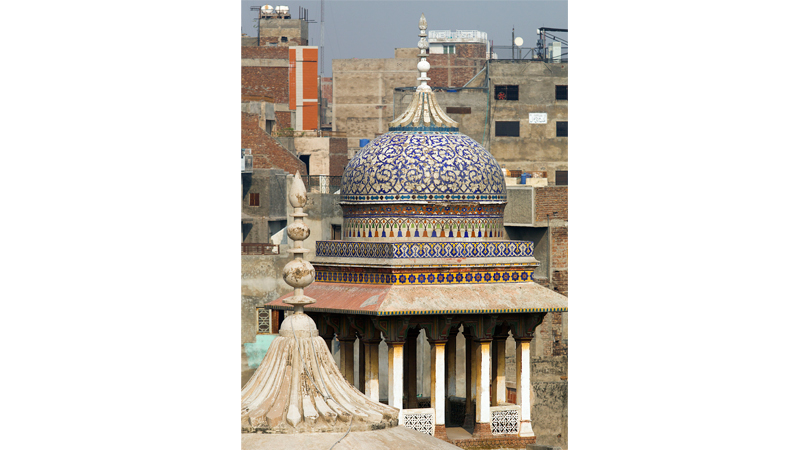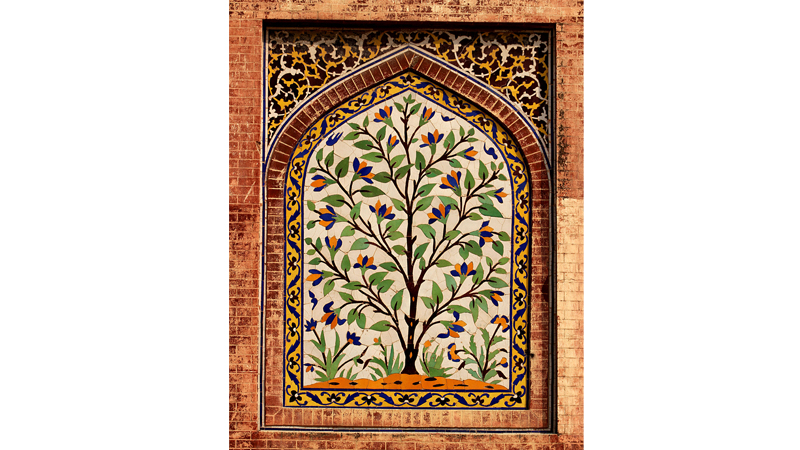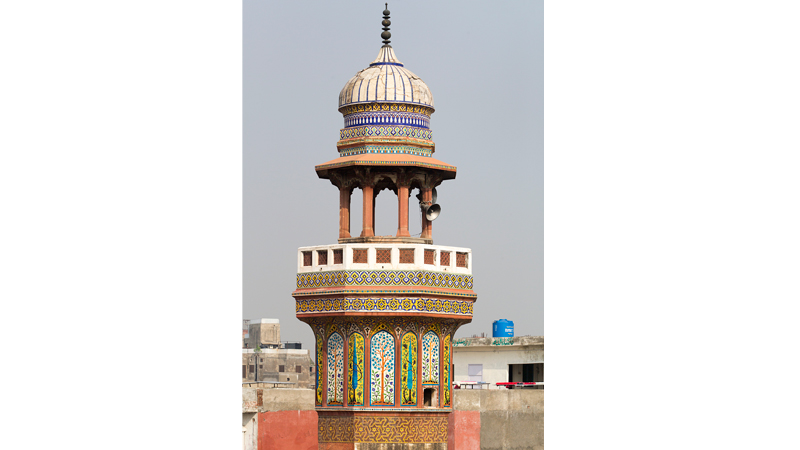 Many of us despite spending our entire lives here in Lahore have no clue where the Wazir Khan Mosque is located despite it being considered the real jewel of Lahore. I must say that Lahore’s beauty and splendor is incomplete without this majestic piece of architecture.
Many of us despite spending our entire lives here in Lahore have no clue where the Wazir Khan Mosque is located despite it being considered the real jewel of Lahore. I must say that Lahore’s beauty and splendor is incomplete without this majestic piece of architecture.
Among the architectural monuments of Lahore, the Wazir Khan Mosque has a very significant position. The dominating features of this mosque are the fresco, vibrant colors and calligraphy. Once you enter the mosque you will feel yourself in a world filled with colours, peace, tranquility and serenity that will appease your mind and soul.
This is a unique monument that not only reflects the spirit and talent of the Mughal builders, but also of the artisans, who remained anonymous but their contributed in tile making, design and wall painting makes visiting the mosque not only a spiritual but also an aesthetic experience.
The mosque was built under the patronage of the governor of Lahore Wazir Khan. It is stated in historic accounts that the mosque’s foundations were laid in 1634 and it was completed in 1641, during the reign of Mughal emperor Shah Jahan. It is said that during Shah Jahan’s reign, architecture flourished across the Mughal empire. His famous masterpieces include the Taj Mahal, Sheesh Mahal Lahore and Shalimar Gardens. The Wazir Khan Mosque is another architectural masterpiece of Shah Jahan’s era and is located deep within the ancient walled city of Lahore, inside Delhi Gate.
The impressive combination of calligraphy, geometrical and floral decoration is unique and makes the Wazir Khan Mosque stand out as an epitome of exquisiteness and beauty, balance and grandeur
You can access this monument while walking on the royal trail which is also known as shahi guzargah. This trail was named so because the Mughals used this route while traveling from Delhi to Lahore Fort. On the route inside Chowk Wazir Khan you will see this grand mosque standing majestically. As you see the monument today, it was not so a few years ago because it was hidden behind numerous encroachments. The encroachments were removed in 2012 by the Walled City of Lahore Authority and its view was made clear for people and tourists.
Wazir Khan selected this chowk or square for this mosque as it was a central place of Lahore at that time and was attached to various parts of the city through perpendicular passages and narrow winding streets. Another reason Wazir Khan chose this site was the tomb of Sayyid Muhammad Ishaq Kazirun who died almost two and a half centuries before the mosque was built. This place had been a school of religious learning, because these were the living quarters of saints who taught spiritual knowledge to seekers.

The main entrance of the mosque is mind blowing! Passing through the magnificent doorway (a monument in itself) is the main gate which is situated on the eastern side of mosque. Recently during an excavation and conservation work in the chowk, the mosque’s façade and the original ground level were also restored and now visitors will have to climb even more stairs to go inside. The main gate is projected two feet outward from its surrounding walls and framed on both sides by attenuated minarets of two feet diameters each, topped by small cupolas. Another gate of the mosque is located on the northern side which opens into a bazaar. This wall and gate has also been recently conserved by the Aga Khan Trust for Culture and Walled City of Lahore Authority.
The arched niche at the mosque’s entrance facing the Wazir Khan Chowk is richly decorated with floral motifs, and features one of Lahore’s first examples of a muqarna – an architectural element found at the Alhambra in Spain, as well as on several imperial mosques in Iran. It is said by the architects and historians that the low domes over the prayer hall reflect the style of the earlier Lodi dynasty, which ruled Lahore prior the Mughal era.
The tomb of saint is inside the mosque’s courtyard and nine steps down from the present level. The courtyard is flanked from three sides that are north, south and east by small rooms called hujras. These are thirty two in number and thirteen each on its northern and southern wings and six on its eastern side that is three on either side of the entrance of the main portal. All the hujras are rectangular in shape but differ in sizes. On the northern and southern wings, the hujras are identical in their dimensions except a minor variation in the northern hujras, that each have a window on their northern walls that opens up into the bazaar. The ablution area is in the center of the courtyard. The blue glittering water gives you a mesmerizing feel.
The most distinguishing feature of the mosque is the four minarets majestically standing at the four comer of the courtyard. This concept was first time employed in Lahore by the Mughal architects and designers. You can have the view of entire walled city from these minarets.
The prayer hall of this mosque which is another architectural masterpiece. It is one of the most embellished prayer chambers of the Mughal era mosques in Lahore and trust me you will be awe stunned by it. The entire chamber is decorated with fresco and calligraphy. These embellishments are not just inside the prayer chamber; these are also seen on the façade, minarets and walls of the mosque. The prayer hall follows the one-aisle five-bay motif that was first formed in Lahore in the Maryam Zamani Mosque, which was later to find its full expression in the Badshahi Mosque built by Emperor Aurangzeb, half a `century later.
Much of the mosque is constructed of cut and dressed brick decorated with glazed tile mosaics. You will notice that the bricks on the mosque’s exterior are richly embellished with title work known as kashi-kari. Façades facing the inner courtyard are embellished with motifs and palette which display strong influences from `the 17th century Persia. Persian-style colors used include lajvard (cobalt blue), firozi (cerulean), white, green, orange, yellow, and purple, while Persian-influenced motifs include star-shaped flowers and grapes. These colors make the mosque look vibrant and lively and anyone visiting the mosque would feel as if it is communicating to them through the colours.

I must say that the interior decorative style is unique for Mughal-era mosques. The inside of the dome feature frescoes depict allusion to the concept of Paradise as told in Islam. The mosque’s complex is listed on the Protected Heritage Monuments of the Archaeology Department of Punjab. The mosque contains some of the finest examples of mosaic tile work from the Mughal period and students and researchers from all over the world visit it to conduct research.
The impressive combination of calligraphy, geometrical and floral decoration is unique and makes the Wazir Khan Mosque stand out as an epitome of exquisiteness and beauty, balance and grandeur.
Published in Daily Times, August 2nd 2018.